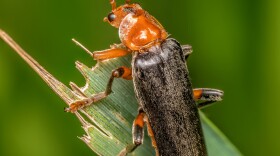When you think of a spider using its silk to capture prey, the image of a fly caught in a sticky web is likely what pops to mind.
But rather than creating a web and simply waiting for the next meal to come along, some spiders take a more active role in capturing their prey.
The net-casting spider is one of the best examples.
While different species of net-casting spiders can be found in tropical regions around the world, there’s only one species found in the southeastern United States …the Ogre-faced spider.
Ogre-faced spiders are unique in several ways:
Unlike most spiders, their bodies are long and stick-like, helping them blend into their surroundings.
In addition, two of their eight eyes are large and forward-facing, giving them surprisingly good eyesight at night – even better than that of an owl.
But it’s not their physical appearance or amazing night vision that make these spiders so unique, it’s how they use their web.
Suspended just above the ground, a branch, or a leaf, they create an incredibly elastic, rectangular web – about the size of a postage stamp –held in its first two pairs of legs.
To increase the chances of seeing prey, the spider will drop white spots of its own droppings onto the surface below …creating a light colored background to better see potential prey.
Once an insect or other suitable meal passes over the white specks, the spider quickly springs downward, stretching the net two or three times its original size and ensnaring its victim, delivering a quick, immobilizing bite, and using the net to wrap up its meal, the Ogre-faced spider is ready for dinner.





